Counter-attacks and boa constrictors
Chess is by nature a drawn game. White has the first move advantage, but due to computers that has more or less been neutralized. It is a game full of hope and possibility. Sometimes the underdogs win, sometimes the favourites. Monday in Biel, the rating favourites won the day, but to say that they were easy wins would severely understate what they had to do on the board. Being an active player myself, I know how difficult it is to win against a charged and motivated opponent. So the four decisive games today are an ode to the fighting spirit of the players, and one hopes that such a trend continues! Without much ado, let us get into the games now:
Georgiadis 0-1 Shankland
The young Swiss talent essayed his usual 1.e4, and Sam replied with the Sicilian. The youngster chose 6.♗e3 against the Najdorf and after 6...e5 went ♘f3, following the trends at the top level. As is typical in the Sicilian, once Black equalizes he usually takes over, and Sam managed to win with a wonderful piece sacrifice! Here are a few of the critical moments from the game:
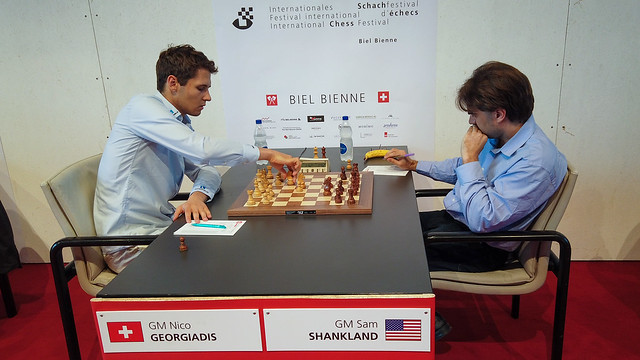
Sam's book has more often than not led him to sacrifice material for an armada of pawns! | Photo: Simon Bohnenblust / Biel Chess Festival
11.♕e2!? is the most commonly played move in this position. I don't see how it is that good, and feel that the move 11.♘h4 is more critical (Sjugirov-Wojtaszek Batumi 2018).
White did get the d5 square, but his lack of co-ordination means that Sam's counterplay is quick to arrive. Here, after the forced queen exchange, I am starting to like Black more and more, as d6 is not really weak, while c2 is. The rook on c1 is quite passive.
They say there are two kinds of sacrifices — correct ones and Tal's! Here Sam went for the interesting ♖xe4! sacrificing the bishop after f4 ♝xf4! gxf4 ♜xf4+. Objectively if White can co-ordinate he should be ever so slightly better, but in a practical game I'd take Black all day. Nico was unable to solve all the problems at the board, and that is proof enough that Sam's idea was practically the best decision to make. As for the sacrifice — it is more Tal-like!
Here Nico rejected the natural ♖cd1 in favour of ♘a5. I don't understand this decision, as chess guidelines dictate that one should mobilize the major pieces to the most active squares first and then improve the minor ones, in the endgames at least. While his game move is not really an error, his subsequent play was not the most precise, and soon he had to find some only moves to stay alive.
The only move to keep dynamic equilibrium for White is ♖c8+! ♚f7 followed by ♖c3 or ♖f1. The point is that the game move f2 or ♜ee2 are bad in lieu of ♖f3+! picking up the pawn soon enough. The active role of the Black king actually hamper Black's chances of counterplay, as White can throw in checks at will, and the kingside pawns are not positioned well enough to support the far advanced f-pawn. Instead, the game was concluded rather quickly after 37.♖h5?? f2! 38.♖f1 Ra1!! and Nico resigned before Sam won the rook after 39.♔g2 ♜g4+ ♔xf2 ♜f4+.
.jpg)
Sam's energetic play gave him his first win in the classical section | Photo: Simon Bohnenblust / Biel Chess Festival
Vidit 1-0 Cori
The fourth Indian to cross 2700 has finally arrived to the party in Biel. Today his smooth positional play was too much for Jorge Cori. Out of a Bogo-Indian, Vidit slowly built up his kingside attack while Cori couldn't do the same on the queenside. A pretty knight sacrifice sealed the deal in favour of the rating favourite soon after. Some highlights now:

A lesson in slow burner attacks was Vidit's objective today! | Photo: Simon Bohnenblust / Biel Chess Festival
The Bogo-Indian is a respected opening but against a positional player like Vidit, it is not the best opening to choose.
Here Cori went 9...♞c6 and was soon under pressure after 10.♘d5.
From here it is just a masterclass in attack from Vidit. White's slow burner on the kingside is underestimated by all engines, but as a human I would start to feel really scared for my king. Black is stuck passively on his side of the board without counterplay.
With such centralized pieces, White's position looks commanding. It was time for Black to stir something up on the queenside with 21...a4!? 22.b4 c6!. Though White is better after 23.♗f1, 23...a3! starts some serious action on the queenside, intending 24...♜a4. It is not clear how the game would have finished had Black decided to play a little more aggressively. Instead, the one move threat after 21...♜b8?! was easily neutralized after 22.♘c3!.
33...♞xh4? from Black was a serious mistake, caused by hours of passivity. After gxf6! Cori should have tried to limit the damage with g6!?. Instead, gxf6? was asking for it, and Vidit didn't hesitate.
35.♘e6+! decides the game after Bxe6 36.♕xf6+ ♝f7 37.♕h6+ ♚e7 38.♕xh4+ ♚f8 39.♕h6+ ♚e7 40.♖g7! 1-0.
 The Caro Kann is a very tricky opening. Black’s play is based on controlling and fighting for key light squares. It is a line which was very fashionable in late 90s and early 2000s due to the successes of greats like Karpov, Anand, Dreev etc. Recently due to strong engines lot of key developments have been made and some new lines have been introduced, while others have been refuted altogether. I have analyzed the new trends carefully and found some new ideas for Black.
The Caro Kann is a very tricky opening. Black’s play is based on controlling and fighting for key light squares. It is a line which was very fashionable in late 90s and early 2000s due to the successes of greats like Karpov, Anand, Dreev etc. Recently due to strong engines lot of key developments have been made and some new lines have been introduced, while others have been refuted altogether. I have analyzed the new trends carefully and found some new ideas for Black..jpg)
One Grandmaster whose games are more often than not under control! | Photo: Simon Bohnenblust / Biel Chess Festival
Leko 1-0 Bogner
After a bad rapid tournament, Bogner's Biel sojourn took a further turn south. After overextending his Slav Defense, he made a superlative comeback, only to throw away the game with one move, just after the time control. Here are some critical moments:

Leko's dream run continues, while Bogner will be hoping to halt his free fall as soon as possible. | Photo: Simon Bohnenblust / Biel Chess Festival
The 4.e3 Slav is the perfect territory for Leko to play to his strengths. In reply, Bogner chose the fianchetto system.
This position has seen the likes of Kasparov and Kamsky on the Black side. However, I really don't like the fact that Black's queenside lacks flexibility. Only further tests will show how sound the position actually is.
Was Bogner in his preparation here? He played dxe4 and gave up an exchange soon after. I admit that the advantage isn't as big as the engines think it is, but here Black had a very fascinating option in f5!, creating a sort of symmetry in the kingside. I'm not sure whether it is better than the game continuation, but it is definitely not worse.
Bogner sacrificed an exchange on a8 and doesn't seem to have enough compensation for it.
Here it was imperative to start queenside operations with a4!. I doubt Black can survive for long after that, as he is in a weird form of zugzwang! Instead, Leko allowed Black to consolidate after ♕d3?! ♛d5! and had to begin converting from scratch.
Bogner is strong enough to see ♛f7! but he must have not realized that the time control was up. 40...h5?? was a sad way to lose after the pretty 41.♕xg7+!
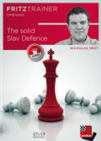 This Slav DVD is a complete opening repertoire for black after 1.d4 d5 2.c4 c6. GM Nick Pert has played the Slav defence for over 10 years and provides all his latest and most up to date analysis crammed into one video series. Nick has spent many hours studying the best Slav lines, and he explains his favourite variations, plus includes some interactive clips where the viewer is tested on a range of theoretical questions and tactics arising from Slav games.
This Slav DVD is a complete opening repertoire for black after 1.d4 d5 2.c4 c6. GM Nick Pert has played the Slav defence for over 10 years and provides all his latest and most up to date analysis crammed into one video series. Nick has spent many hours studying the best Slav lines, and he explains his favourite variations, plus includes some interactive clips where the viewer is tested on a range of theoretical questions and tactics arising from Slav games.
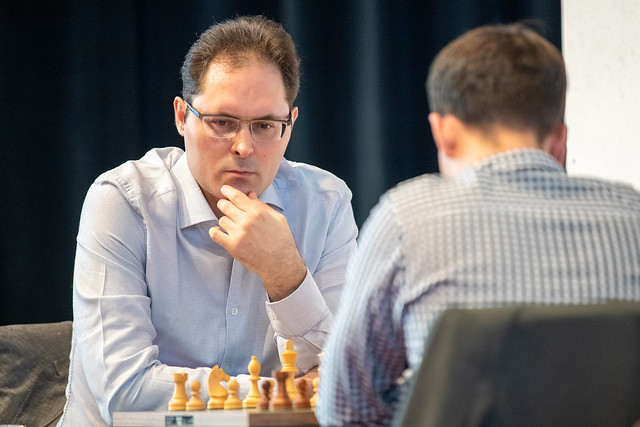
Focused, determined, and scarily strong - that's Peter Leko for you! | Photo: Simon Bohnenblust / Biel Chess Festival
Abdusattorov 0-1 Maghsoodloo
Yet another Sicilian going against the underdog. This one was a Rauzer, and after a novelty on move 16 by Maghsoodloo, the game appeared to be in dynamic balance. But as is the case in such encounters, Black had a psychological advantage of coming 'back' from a slightly worse position, and being the stronger player he soon started to press. Not long after, Abdusattorov committed a grave error, and Maghsoodloo brought the point home, though not in the cleanest fashion. Here are the interesting moments in the game:
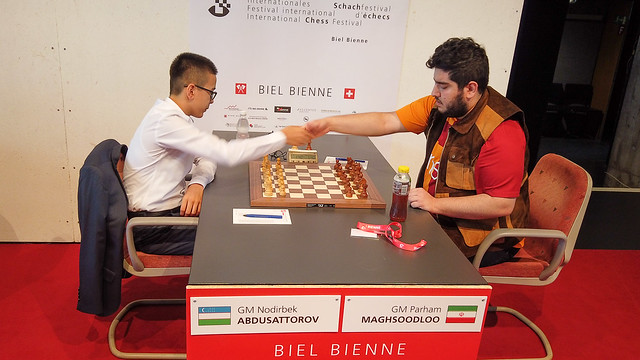
A future World Championship match? | Photo: Simon Bohnenblust / Biel Chess Festival
The Richter-Rauzer isn't as common as it once was, but remains a serious option for Black to fight for a win.
Here Abdusattorov went g5!? and Black was soon fine. Instead, h4! looks like a better option to me, bringing in all the artillery. It has been surprisingly underused. Perhaps not any more after this game...
19.♞e2!? looks to be a better option than 19.♗h6 (the game move) for White, bringing in the last piece into the attack and retaining hopes of an advantage. The idea is to meet the natural ♛a5 not with ♔b1 (which leads to a forced draw after ♝a4! [♘d4 ♝xd4 ♖xd4 ♝xc2+ ♔a1 g6 hxg6 hxg6 ♖xd7 ♝b3! and White has to force the draw with ♕xg6!]) but with ♗g5! and the threats to the Black king start to turn real.
21.e5? was a gross miscalculation from the young phenom. Now, instead of taking on e5 (which is what Parham did), the strong 21...♝h4! wins two pieces for the rook. The idea is to start a ferocious counter-attack after 22.♛g4 bxc3 23.♗xf8 ♚xf8! 24.♕b4+ ♚g8 25.♕xc3 ♝d5! — with a decisive advantage.
It was time to apply the emergency breaks with 24.♗xa6! bxc3 25.♕xc3+ ♛f6 26.♕xf6+ ♚xf6 27.♗xc8 ♜xc8 28.♖d4. Black has an advantage, but the three connected passed pawns on the queenside means that conversion will not be easy. Instead, after 24.♘e2? Parham began his counter-attack with ♛f6!
Instead of the natural 27...♜fd8?! that Parham played in the game, Black had the super strong ♞a4!, threatening to take on b2 and then on c2 with the rook. White is forced to play ♕b3, but now ♜fd8! wins a full piece and soon the game will be decided. After the game move, Nodirbek only resigned on move 41.
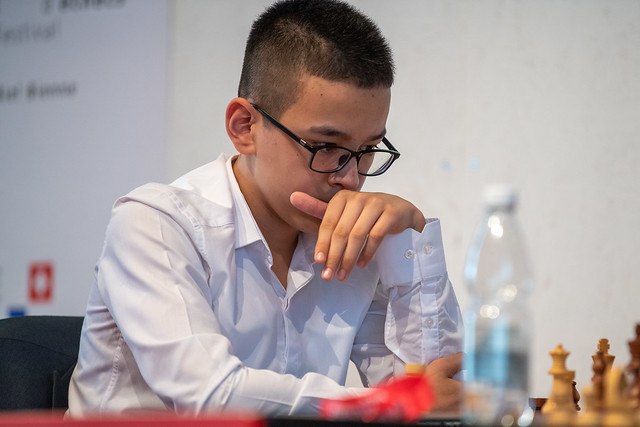
This young super talent has played admirably so far. How far can he go in his biggest challenge yet? | Photo: Simon Bohnenblust / Biel Chess Festival
The trends are now clearly set, and it remains to be seen whether they continue.
Here are the standings, where each player retains their position in lieu of results going as planned for some (and not so for others):
Overall Ranking
| Rank |
Name |
Games |
Classic |
Rapid |
Blitz |
Total |
| 1 |
GM Peter Leko |
8 |
3 |
10 |
0 |
13 |
| 2 |
GM Sam Shankland |
8 |
3 |
9 |
0 |
12 |
| 3 |
GM Parham Maghsoodloo |
8 |
3 |
8 |
0 |
11 |
| |
GM Santosh Vidit |
8 |
3 |
8 |
0 |
11 |
| 5 |
GM Jorge Cori |
8 |
0 |
7 |
0 |
7 |
| 6 |
GM Nico Georgiadis |
8 |
0 |
6 |
0 |
6 |
| 7 |
GM Nodirbek Abdusattorov |
8 |
0 |
5 |
0 |
5 |
| 8 |
GM Sebastian Bogner |
8 |
0 |
3 |
0 |
3 |
All classical games
Links
.jpeg)


















.jpg)

.jpg)









